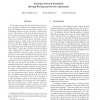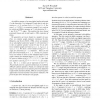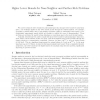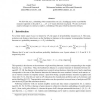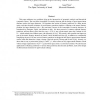101
click to vote
FOCS
2006
IEEE
15 years 4 months ago
2006
IEEE
We consider random 3CNF formulas with n variables and m clauses. It is well known that when m > cn (for a sufficiently large constant c), most formulas are not satisfiable. How...
138
click to vote
FOCS
2006
IEEE
15 years 6 months ago
2006
IEEE
A local graph partitioning algorithm finds a cut near a specified starting vertex, with a running time that depends largely on the size of the small side of the cut, rather than...
143
click to vote
FOCS
2006
IEEE
15 years 6 months ago
2006
IEEE
We introduce a game theoretic model of network formation in an effort to understand the complex system of business relationships between various Internet entities (e.g., Autonomou...
114
click to vote
FOCS
2006
IEEE
15 years 6 months ago
2006
IEEE
An additive spanner of an unweighted undirected graph G with distortion d is a subgraph H such that for any two vertices u, v ∈ G, we have δH(u, v) ≤ δG(u, v) + d. For every...
118
click to vote
FOCS
2006
IEEE
15 years 6 months ago
2006
IEEE
We prove an upper bound, tight up to a factor of 2, for the number of vertices of level at most in an arrangement of n halfspaces in Rd , for arbitrary n and d (in particular, the...
121
click to vote
FOCS
2006
IEEE
15 years 6 months ago
2006
IEEE
How much can randomness help computation? Motivated by this general question and by volume computation, one of the few instances where randomness provably helps, we analyze a noti...
105
click to vote
FOCS
2006
IEEE
15 years 6 months ago
2006
IEEE
We convert cell-probe lower bounds for polynomial space into stronger lower bounds for near-linear space. Our technique applies to any lower bound proved through the richness meth...
FOCS
2006
IEEE
15 years 6 months ago
2006
IEEE
FOCS
2006
IEEE
15 years 6 months ago
2006
IEEE
111
click to vote
FOCS
2006
IEEE
15 years 6 months ago
2006
IEEE
We prove that the hit-and-run random walk is rapidly mixing for an arbitrary logconcave distribution starting from any point in the support. This extends the work of [26], where t...

